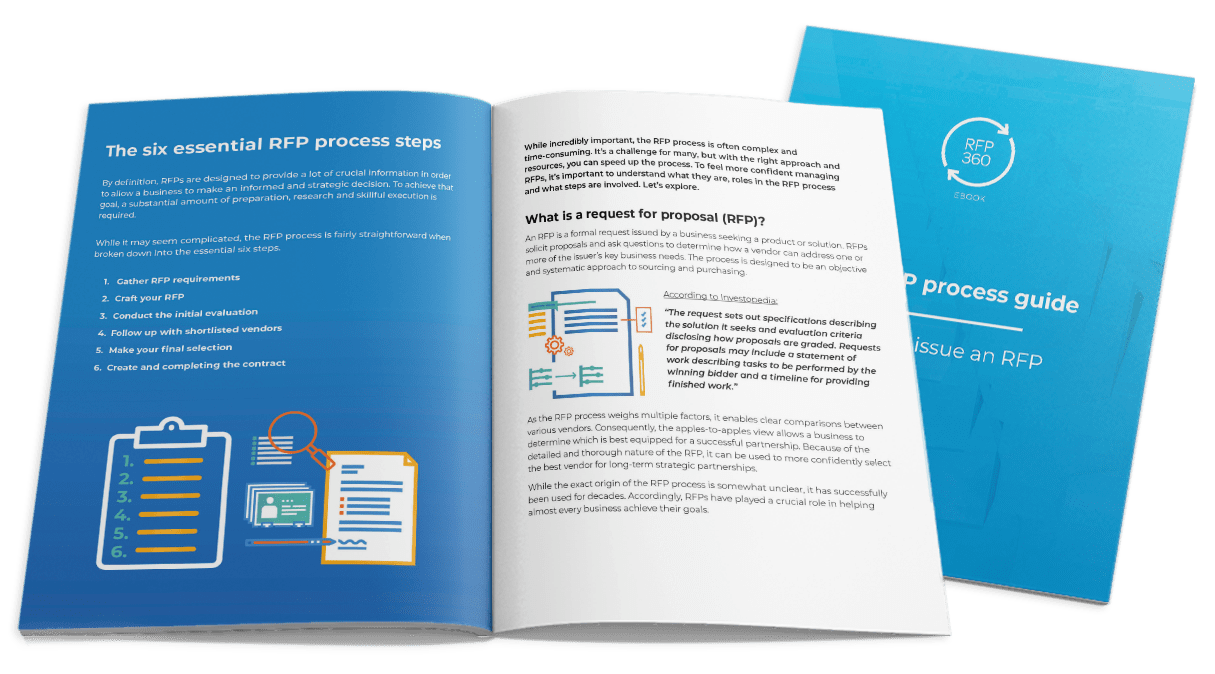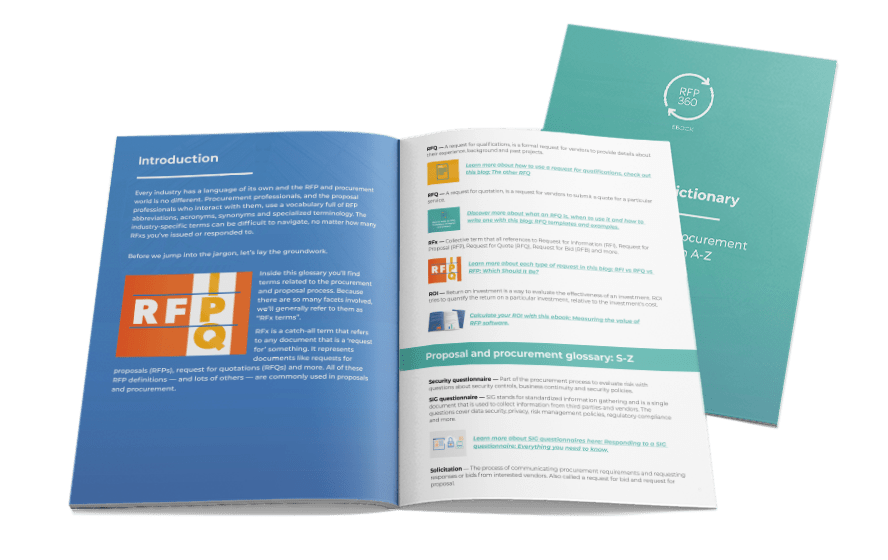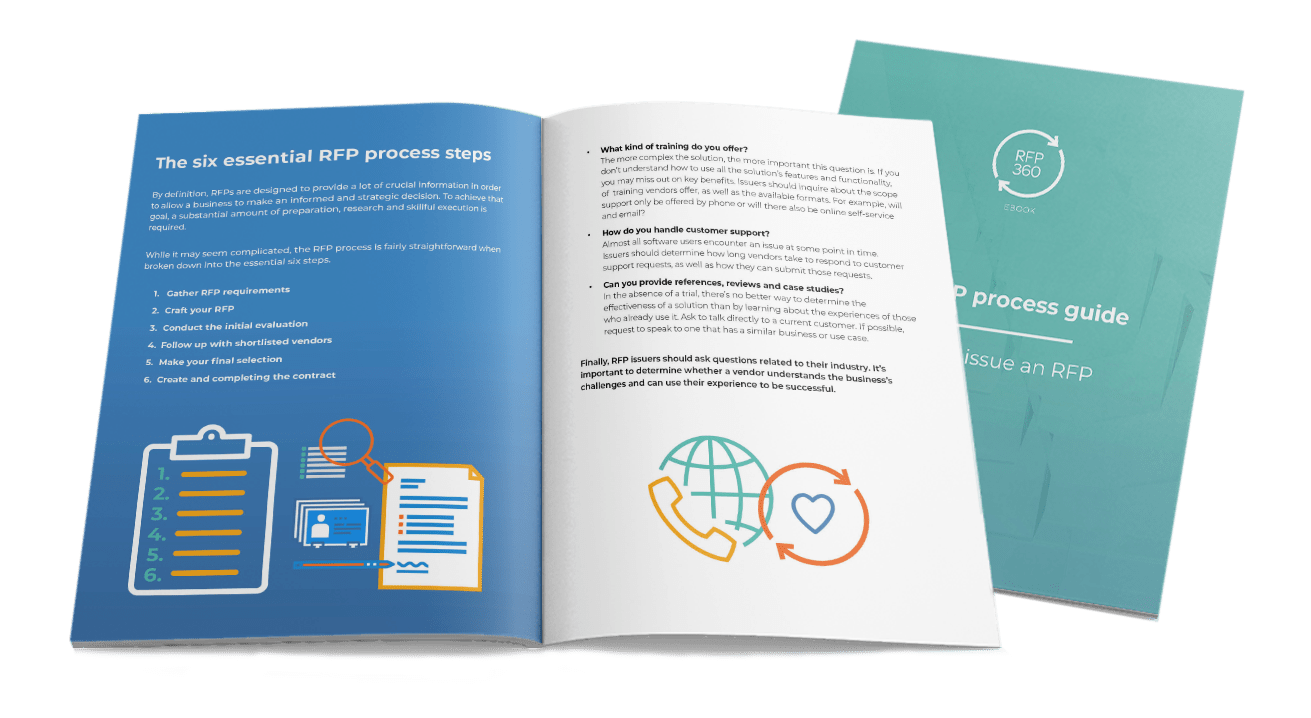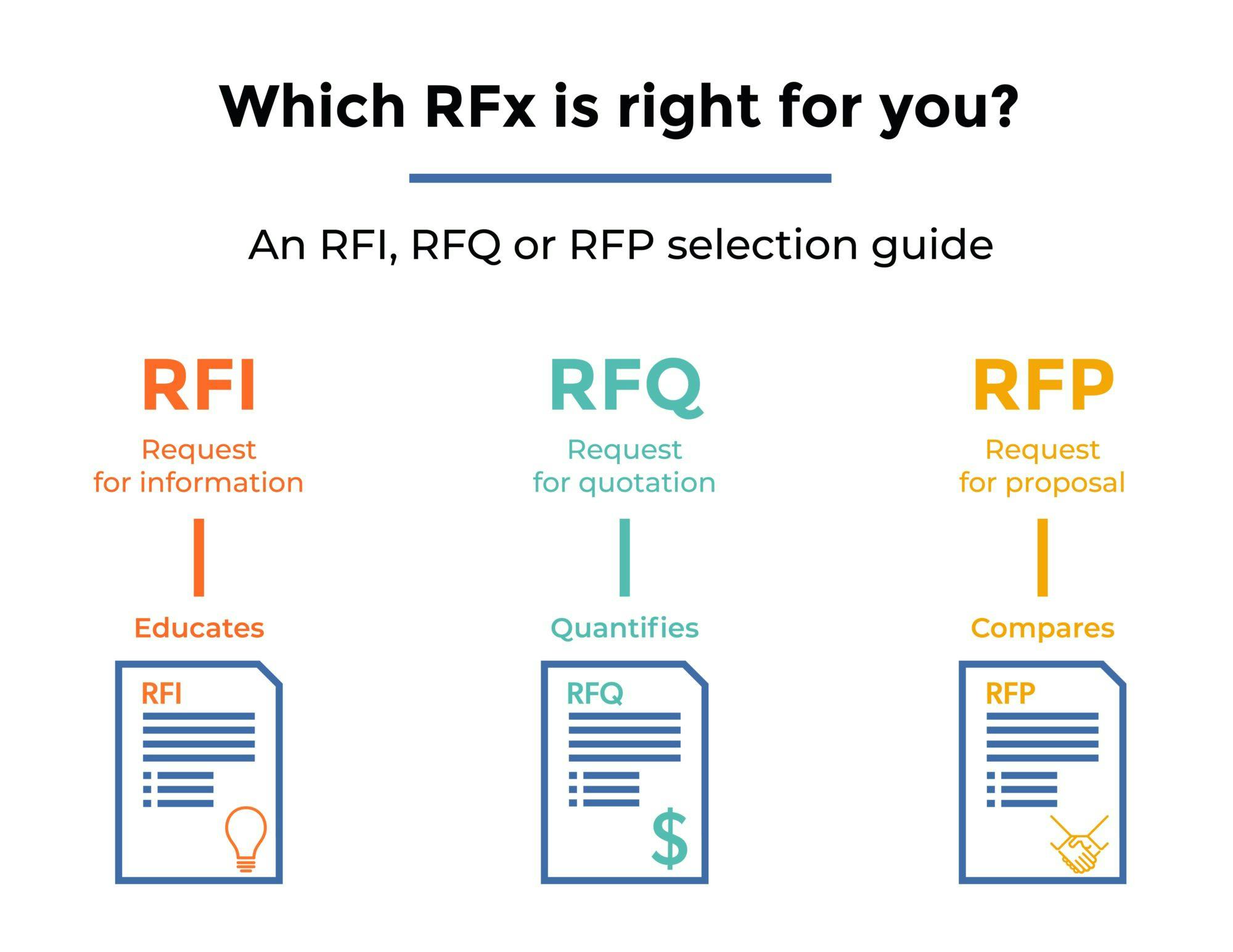The request for proposal, often referred to as an RFP, is a common business tool used to find the best vendor while maximizing value and minimizing risk. Despite its importance and wide usage, many professionals have lingering questions about the RFP meaning, process, acronyms and people involved. Luckily, we’re here to explore everything you need to know about RFPs.
First, we’ll start by answering basic questions. For example: What does RFP stand for? What does RFP mean? And, what is an RFP? Then, we’ll define related terms commonly used during the RFP process. We’ll also explore how RFPs work, who uses them and when they should be used. Finally, we’ll share how technology, like an RFP software, improves and complements the traditional RFP process.
For an in-depth exploration of the RFP process, download the RFP process guide ebook.

RFP definition
RFP meaning: What does RFP stand for?
RFP stands for request for proposal. An RFP is a formal, questionnaire-style document issued to prospective vendors from an organization that intends to buy a product or service. The RFP provides background information to potential vendors, asks key questions and invites them to submit a proposal to meet the need.
In business, an RFP is used by buyers to gather important information from sellers in an organized way. For example, if your organization needs to purchase new software, they likely want to explore several options and compare them.
Rather than asking each sales representative various questions through email or over the phone, the RFP asks vendors the same questions at the same time. Then, vendors respond in a standardized format, called a proposal, making it easy for buyers to compare features, benefits, experience and value. Essentially, businesses use RFPs to make objective, data-based purchasing decisions.
Additionally, Techopedia offers this explanation of the RFP meaning. They define an RFP as “a document issued by a business or an organization to request vendor bids for products, solutions and services.”
Proposal meaning
As mentioned above, RFP stands for request for proposal. Accordingly, it’s also important to know the definition of a proposal. A proposal is the response to an RFP. It answers questions in the RFP and formalizes a seller’s bid. Naturally, the vendor writes the proposal hoping to persuade the RFP issuer to buy a product or service. Accordingly, the proposal should detail how the vendor meets the needs of the buyer.
To learn more about RFP responses, explore this blog: Understanding the RFP process.
When simplified, the RFP process includes three steps: issuing the RFP, collecting proposals and scoring RFP responses to select a winner. Ultimately, RFPs enable businesses to determine which vendors are best qualified to help overcome a challenge or achieve a strategic objective.
RFP-related terms
In addition to learning the RFP meaning, you may find yourself with questions about other RFP-specific terminology. Admittedly, there are a lot of abbreviations, acronyms and jargon involved when using RFPs in business. Here’s a quick guide with links the most commonly used terms:
RFx and other document definitions
- RFx – The term RFx is a stand-in abbreviation that refers collectively to any of the common "request-for ____" documents. For example, requests for information, requests for quotation, requests for qualifications, requests for proposals and so on.
- RFI – A request for information (RFI) is a document that solicits general information about the solutions and/or services vendors provide. Organizations generally issue an RFI prior to the RFP process.
- RFQ – Request for qualifications, abbreviated as the acronym RFQ, is a procurement tool often used in construction that focuses on experience and expertise.
- RFQ – A request for quotation (RFQ) is a document that solicits pricing and payment information. Organizations often use this type of request when they know what type of solution they want and are only evaluating vendors based on price.
Note: Some industries, like architecture, engineering and construction define RFQ as a request for qualifications. This document focuses on experience and certifications rather than price.
- BRD – A business requirements document (BRD) is a formal document that outlines the goals and expectations an organization hopes to achieve by partnering with a vendor to complete a specific project.
- FRD – A functional requirements document (FRD) is a formal document that outlines how an organization expects their vendor to help them achieve a strategic business goal.
Procurement process terms
- Procurement – Procurement is a term that refers to the process organizations undergo when making a purchase. The RFP process falls under the procurement umbrella.
- Weighted scoring – RFP weighted scoring is an approach to proposal scoring that enables objective vendor evaluation. It allows buyers to compare vendors by awarding points based on their responses to a questionnaire.
- Spreadsheeting – Spreadsheeting is often used to describe the RFP process when the issuing organization manually manages and scores vendor responses using spreadsheets.
Note: This practice becomes less common as organizations adopt RFP management systems to digitize their processes.
- Vendor due diligence – Vendor due diligence, also known as buy-side due diligence, is the process of evaluating the risks involved in a partnership with a potential vendor. Due diligence questionnaires help organizations avoid or mitigate threats.
- Sourcing – Sourcing is the process in which organizations identify and select vendors. Often, RFPs are a standard part of the sourcing process.
- Vendor management – Vendor management is the practice of optimizing relationships with vendors and suppliers to receive better products, services and support, while reducing costs. It’s also known as supplier relationship management.
- Vendor selection – Vendor selection is the process that determines which vendor to purchase from and/or partner with.
For even more procurement and proposal vocabulary, download the full RFx glossary to explore additional terms and RFP definitions.

How do RFPs work? An overview of the RFP process
The goal of the RFP process is to define your business challenge and then find the right vendor to meet that need. Identifying the right vendor means focusing on more than just price. RFPs allow buyers to create a complex side-by-side vendor comparison of important factors. For instance, the RFP may ask about reliability, experience, quality, policies and security.
Understandably, taking on a high-value, strategic RFP can be overwhelming. However, when broken down into its basic components, the RFP process is quite simple and can be broken down into three core steps: RFP creation, administration and evaluation.
The RFP timeline
This RFP process timeline provides a high-level overview of how RFPs work.
- The business identifies a need, begins researching solutions, receives approval for the purchase and writes the RFP.
- Next, they issue the RFP to prospective vendors, kicking off the vendor proposal process.
- Finally, they receive the RFP responses, evaluate them and select a winner.

The RFP process overview
1. Creation
Identify the need
First, the RFP team, led by the procurement manager, must come together to decide exactly what they’re looking for. Indeed, stakeholders, end-users, IT, finance, and any other teams who will be impacted by the procurement decision are involved in the initial requirements gathering process.
Define scope and goals
Together with stakeholders, you must define the need, meaning the challenge they want to overcome or goal they want to achieve, as well as what success will look like. In addition, they must help create RFP questions, establish scope and prioritize RFP criteria.
Write a meaningful RFP
Next, it’s time to write the RFP. If possible, it is helpful to start with an RFP template and customize it.
Sections to include in your RFP
- Company information
- RFP timeline
- Overview of current state
- Banking services required (ACH, wire transfers, direct deposit)
- RFP requirements and evaluation criteria
- Project scope and services requirements
- RFP questions
- Vendor information and company structure
- Company performance
- Banking services approach
- Experience and customer references
- Personnel and account management
- Competitive differentiators
- IT and data security protocols
- Reporting, statements and analysis delivery
- Pricing proposal
- Terms and conditions
- Attachments
Helpful RFP questions
Don’t forget to follow best practices and include questions that speak to your specific needs and situation. For example, these questions can be adapted to almost any procurement project.
- Who are your competitors? Asking this question can help issuers determine a vendor’s integrity. It lets issuers know whether the vendors are honest about who their competitors are and why they lose to them. It can also help issuers determine if there are other options they should explore.
- What is your implementation process like? When purchasing software, including customer success questions is key. RFP issuers should determine how long the onboarding process will take. In addition, explore available support and self-service options.
- What kind of training do you offer? The more complex the solution, the more important this question is. If you don’t understand how to use all the solution’s features and functionality, you may miss out on key benefits. RFP issuers should inquire about the scope of training vendors offer, as well as available formats.
- Can you provide references, reviews or case studies? Certainly, there’s no better way to determine the effectiveness of a solution than by learning about the experiences of those who already use it.
Asking the right questions gives your RFP meaning and ensures you’ll have the information you need to make a confident decision.
2. Administration
Select vendors and issue your RFP
Now that you have your RFP written, it’s time to gather vendor proposals. Ideally, you’ll want to receive no more than six responses from only the most qualified vendors. In most cases that means, you’ll develop a list of vendors and ask them for responses directly, but some organizations also use bid services that post their RFPs publicly. This option can increase your responses, but it will likely lead to several irrelevant responses. Consequently, you’ll invest more time in scoring.
If you manage RFPs using Word and spreadsheets, you’ll likely send your RFP invitation to vendors via email.
As you can imagine, sending an RFP manually will result in a lot of inbox clutter. So, if efficiency is a priority, consider using an RFP management system. Designed to centralize and automate every step of the RFP process, RFP tools improve collaboration and cut the time required to issue an RFP by up to half.
Respond to vendor questions
No matter how thorough your RFP, vendors will often have follow-up questions. They may seek clarification on the timeline or need more information about your requirements.
Gather all vendor questions and answer them in a single document. Then, send your question and answer document to all vendors to ensure everyone is working from the same information.
Once again, responding to vendor questions is much easier in a request for proposal tool that centralizes communications and allows you to track real-time vendor progress.
Follow up with vendors
It’s helpful to send vendors a quick reminder when the RFP deadline nears. Be sure to let them know you’re looking forward to their proposal. And, remember to reinforce the anticipated date of your final decision.
3. Evaluation
Review proposals
Once you’ve gathered your vendor responses, you’ll want to score their answers. We recommend taking a weighted scoring approach to help prioritize your decision factors. Weighted scoring establishes point values for sections and individual questions in the RFP based on their importance. This allows you to objectively determine which vendor truly best fits your needs.
Using the criteria you established previously, assign your project stakeholders sections of your RFP to score. As you review scores, take the opportunity to compare feedback from various stakeholders to ensure that you address any discrepancies between scorers.
Select your shortlist
Based on your initial proposal evaluation, you can create a vendor shortlist — a list of five or so vendors who you will move on to the final stages of the RFP process. All the vendors in your shortlist should be serious contenders that you can picture your organization partnering with. Ask these RFP finalists clarifying questions or request an RFP presentation to help you make your final decision..
Negotiate
This is the stage where you ensure your organization is getting the best deal possible. Begin vendor negotiations by asking yourself a few questions. Is there a vendor on your shortlist that would be well ahead of the rest of the pack if they just came down on price? Let them know. Most vendors will be happy to negotiate a bit — especially if they know how close you are to a purchasing decision. Remember, be as transparent as possible with your expectations and let the vendor know what potentially winning the RFP means for them.
Pick the winner and sign
Now to the fun part: Making your actual selection. Make sure to inform the vendor you’ve selected using an RFP award letter, as well as the vendors you didn’t using a proposal rejection letter. Remember to be respectful and consider offering feedback. Just because you didn’t select a vendor today doesn’t mean they won’t be a viable option for your organization in the future.
With that done, it’s time to make it official. Be sure to have a lawyer review all contract language before you sign anything. You want to make sure everything is set up according to your expectations.
While this guide gives a helpful overview, there’s more to explore in this ebook: The RFP process guide. Download it now for a deeper dive into the RFP process.

Who is involved in the RFP process?
The RFP process involves several key stakeholders, including
- Stakeholders – The department head or employee with the purchase need. They are involved in establishing criteria and scoring the RFP.
- Procurement professional – The procurement professional may be either a procurement manager or strategic sourcing manager. They coordinate the creation of the RFP and manage the process from beginning to end. They work with internal team members and external vendors.
- Consultant – The RFP consultant is responsible for understanding the needs of their client and properly explaining those needs within the RFP. They are also responsible for finding vendors to submit proposals and helping assess their qualifications.
- CFO or CPO – The chief financial officer or chief procurement officer will evaluate costs and return on investment (ROI) to determine whether a solution is financially viable.
- Vendors — The vendors are the organizations who respond to the RFP. These are the businesses that the buyer ultimately purchases from or partners with.
- Proposal manager — The proposal manager is the person managing the RFP response for the vendors. They are responsible for gathering information from their subject matter experts (SMEs), reviewing proposals for compliance and ensuring bids are submitted before the deadline.

When do you use an RFP?
One of the biggest mistakes we see with RFPs is that organizations often use them at the wrong time. Generally, this is due to a misunderstanding of the RFP meaning and purpose. Unfortunately, using the wrong RFx document can cause frustration for both stakeholders and vendors. That’s why it’s critical to understand when you should issue an RFP versus an RFI or an RFQ.
We’ve created this handy RFx selection flowchart infographic to help you pick the right document for your project. But below you’ll find a brief description of when you should use an RFP, RFI or RFQ.

The difference between common RFx documents
Request for proposal (RFP)
Use an RFP when:
- You’re certain you want to make a purchase
- You have specific questions you want to address
- You have a good idea what you want, but you need more details
Tip: Remember, issuing an RFP is a formal process and it requires a great deal of effort for vendors to create their proposals in response. You should know what you’re trying to solve and be close to making a purchase but still open to suggestions from potential vendors.
Request for information (RFI)
Use an RFI when:
- You’re seeking general information
- You only have broad questions
- You’re not sure what you’re look for
Tip: The RFI process is much less formal than issuing an RFP. If you have a challenge you want to overcome or a goal you want to achieve, but you’re not 100 percent sure you’re going to make a purchase, this is a much better option. It helps you quickly get the information you’re looking for without asking for a major commitment from potential vendors.
Request for quotation (RFQ)
Use an RFQ when:
- You know exactly what you want
- All available solutions are extremely similar
- You only want to compare vendors based on price
Tip: Because RFQs focus solely on pricing and payment terms, you only want to use this option when you don’t need additional information. If you’re open to suggestions on how to achieve your goals or overcome your challenges, you’re better off issuing an RFI or RFP.
Resources and technology for better RFPs
Helpful RFP resources
Whether you issue RFPs or respond to them, there’s are a ton of resources available to help make the process easier and more efficient. For example, you may want to explore RFP templates or see the best RFP examples to draw inspiration from. So, if you’re ready to dig deeper, here are some of our favorite resources:
- RFP executive summary guide
- How to write an RFP invitation email to vendors
- RFP research: Procurement statistics to know
- How to write an effective RFP
- Top RFP training resources
- How to use a vendor comparison matrix
RFP technology
The RFP process involves a lot of moving parts and can easily become very cumbersome and time-consuming. That’s why organizations often use procurement technology to streamline the process. Unfortunately, many organizations turn to manual tools like Excel, Outlook and Word to manage their RFPs — which can be risky.
“There’s a lot of workarounds for not having RFP management software, but they’re just not the right tool for the job,” explained Brandon Fyffe, business development associate at CareHere.
Benefits of RFP software
Create faster RFPs
If you issue RFPs regularly, you’ll quickly notice that you include a lot of the same information and ask a lot of the same questions. RFP software helps by storing and organizing RFP templates, sections and questions. Therefore, subsequent RFPs are easier and faster to create.
This helps organizations like Lockton — which issues RFPs on behalf of its clients to help them identify property and casualty, employee benefits and retirement solutions providers — deliver an improved procurement experience for everyone involved.
“We had templates in Excel, but we’d always have to add customizations. Then, we’d send multiple copies of those spreadsheets via email, and we’d have to track those emails individually,” said Eric Hollenbach, HR technology consultant at Lockton. “Responsive helped us streamline our templates so we don’t have to add as much. We’re a billable-hour practice, so that reduction in time is great for clients. Additionally, we now have time to ensure our vendors understand the questions.”
Track and gather vendor responses
RFP management technology also delivers enhanced visibility into the vendor response process so you can keep everything on schedule. Vendor proposal progress is tracked in real time. This capability helps users at NFP — a leading insurance brokerage and consulting firm — save time and avoid unnecessary follow up and reminder emails.
“Now, we know exactly when they open their RFP invite and if they’re working on their response,” said Mark Rieder, SVP of HR technologies and benefits administration at NFP. “It doesn’t take six emails to see their completion status.”
Score proposals side by side
Finally, Responsive makes it easy to score RFP responses so you can find and select the right vendor — which is, after all, the entire point of the RFP process in the first place.
At ihouse — a consulting firm specializing in HRIS analysis and system selection, project management and systems consulting — users find this feature particularly helpful.
“What’s been most helpful about using Responsive is the automated scoring,” said Ronni Beckwith, principal, HR technology consulting practice leader. “Before, when using an Excel template, we would have to go through each category to ensure there were no errors from all the copy and pasting. The Excel formulas would often break in the process. It took a lot of time to reconcile.”
To learn more and discover how Responsive can improve your RFP process, request a personalized demo.

